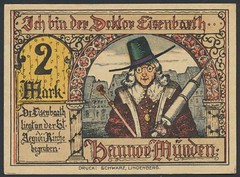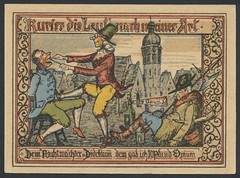
PREV ARTICLE
NEXT ARTICLE
FULL ISSUE
PREV FULL ISSUE
IMAGES OF DENTISTRY ON PAPER MONEY
Last week Gosia Fort of the University of Pittsburgh Health Sciences Library System inquired about images of dentistry on paper money. Reader Ben Swanson of Baltimore responded.
-Editor
Ben writes: I have a large collection of these items. I have pursued them for 45 years. I am mentioned in the Vlack book, page vii, under Acknowledgements. All but one or two of the medical and dental banknotes pictured in the book are mine. I am familiar with Notgeld and wrote an article about the best piece several years ago. I can send details as well as color scans of the note. Gosia Fort replied: Thank you so much for contacting me and for the wealth of information on the paper money with the dentistry theme. I planning a small exhibit which would highlight some items from my library's rare book collections related to dentists. I want to focus on portrayal of dental profession in popular culture (literature, anecdotes, caricatures). The image of the Notgeld would be a wonderful addition. I will properly attribute you as the source.
Here is an excerpt from Ben's attached article. Thanks!
-Editor


Paper money of interest to medicine has long been known and catalogued. Paper money related to dentistry on the other hand is virtually unknown. Newerla categorizes medical paper money thus: 1) currency notes of medical interest; 2) German emergency scrips of medical interest; and 3) the Sun-Yat-Sen currency notes of China. None of Newerla's listings are United States issues. It is the second category which we will address in this article. Newerla's listing of notgeld (German for "emergency money") does not contain a single dental item. I have long collected this colorful medical series because of its attractiveness and esoteric appeal. While attending a New York paper money convention in 1979 I was alerted by a fellow collector to the possible existence of a dental notgeld note. He had not seen the piece, but had been told of it. I began a search which took over two years. One would think that just knowing of a particular piece, the country and the category, would quickly turn up knowledge of it. Not so with notgeld. Notgeld collecting fell into disfavor for a time, but through it all one patient investigator dedicated his life to collecting and cataloguing it. The efforts of Dr. Arnold Keller (1897-1972) fill eleven volumes. He began collecting the series when the first notes appeared in 1914. He was the first to admit that his catalogs were incomplete, although one volume lists 50,000 varieties of notgeld! The problem I ran into trying to locate one specific note, while not knowing the city of origin, begins to be appreciated. The great day occurred in Munich at the largest German numismatic event of the year, where three hundred and fifty dealers gathered under one roof; it was larger than the American Numismatic Association's annual convention. I methodically went to every dealer to ask about a piece of dental notgeld. Two or three of these dealers specialized exclusively in notgeld. At the end of the day I was empty handed. By this time I was beginning to believe the note did not exist. Then an American dealer living in Germany, who had been away from his table when I went around, approached me with a question. "Aren't you the collector of dental material living in Spain?" "Yes." "Well, I have a bank note with a dental scene on it, for you." After I knew the city of origin it was not difficult to purchase duplicates from the very same notgeld dealers who had never heard of a dental note. The note is part of a series of five issued by the city of Hannov Munden in 1922. The denominations are 25, 50 pfennigs, and 1, 1.25 and 2 marks. The two-mark piece is the note of interest. The others in the series do not reflect a medical theme. It is listed as 454 in Dr. Keller's volume entitled "Das Deutsche Notgeld Kleingeldscheine 1916-1922, Part 2." This volume is in German but a translation of the introduction is available from Dwight Musser. Mr. Musser also publishes a notgeld newsletter and various checklists for topical collectors of notgeld. One of these checklists is for medical and health themes. Had I known of Dwight Musser in 1979, it would have shortened my search for the dental notgeld., for Musser's checklist contains it. The note itself measures 69 x 96 mm, it is multicolored and was printed by Schwarz, Lindenberg. On the obverse (Figure 1) Dr. Eisenbarth is holding a large metal enema syringe or clyster and a gold-headed walking stick. The opening words to a university drinking song appear at the top, "Ich bin der Doktor Eisenbarth." To the left, the denomination 2 Mark, and below that, "Dr. Eisenbarth is buried in the church of St. Aegidius." Johann Andreas Eisenbarth was born in 1663 in the town of Oberviechtach in Bavaria to Matthias and Maria Eisenbarth. He was an itinerant oculist, surgeon, and lithotomist. Dr. Eisenbarth was a preceptor-trained physician turned itinerant showman surgeon and oculist. Hoffman-Axtheim states he roamed through the German countryside for 40 years with a traveling show that included a 100 to 120 person entourage of conjurers, musicians, comedians and assistants. He performed cataract surgery, hernia operations, and bladder stone removal in addition to tooth extractions. Despite a measure of success and some recognition from nobility, “Doctor” Eisenbarth was widely believed to be a charlatan. This feeling was reinforced some years after his death with the publication of a satirical drinking song, "Ich bin der Doktor Eisenbarth,” by university students. The wildly popular folk song was published over many years with different versions in German and Polish and with translations into English and other languages.
To read the earlier E-Sylum article, see:
The Numismatic Bibliomania Society is a non-profit organization promoting numismatic literature. See our web site at coinbooks.org. To submit items for publication in The E-Sylum, write to the Editor at this address: whomren@gmail.com To subscribe go to: https://my.binhost.com/lists/listinfo/esylum All Rights Reserved. NBS Home Page Contact the NBS webmaster 
|